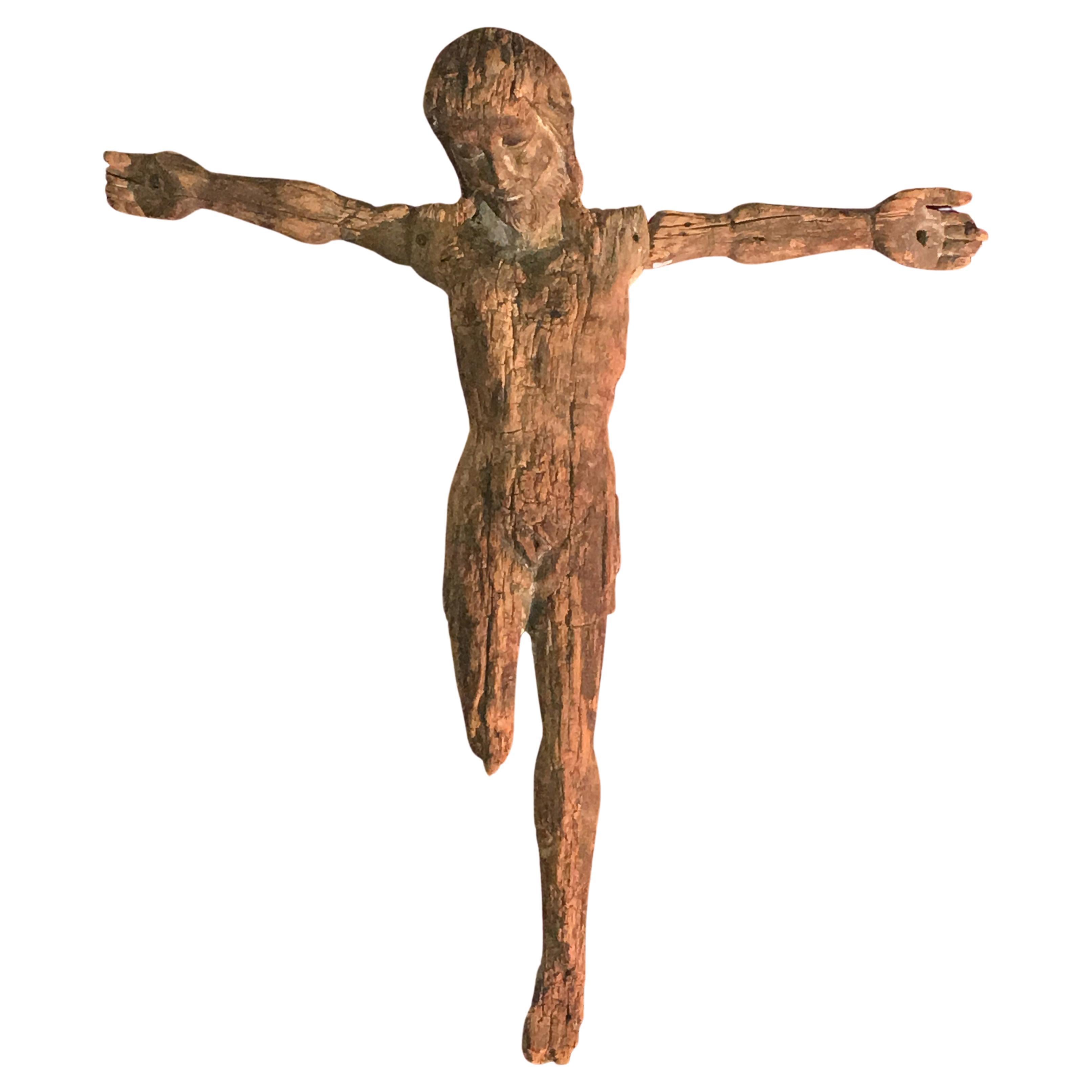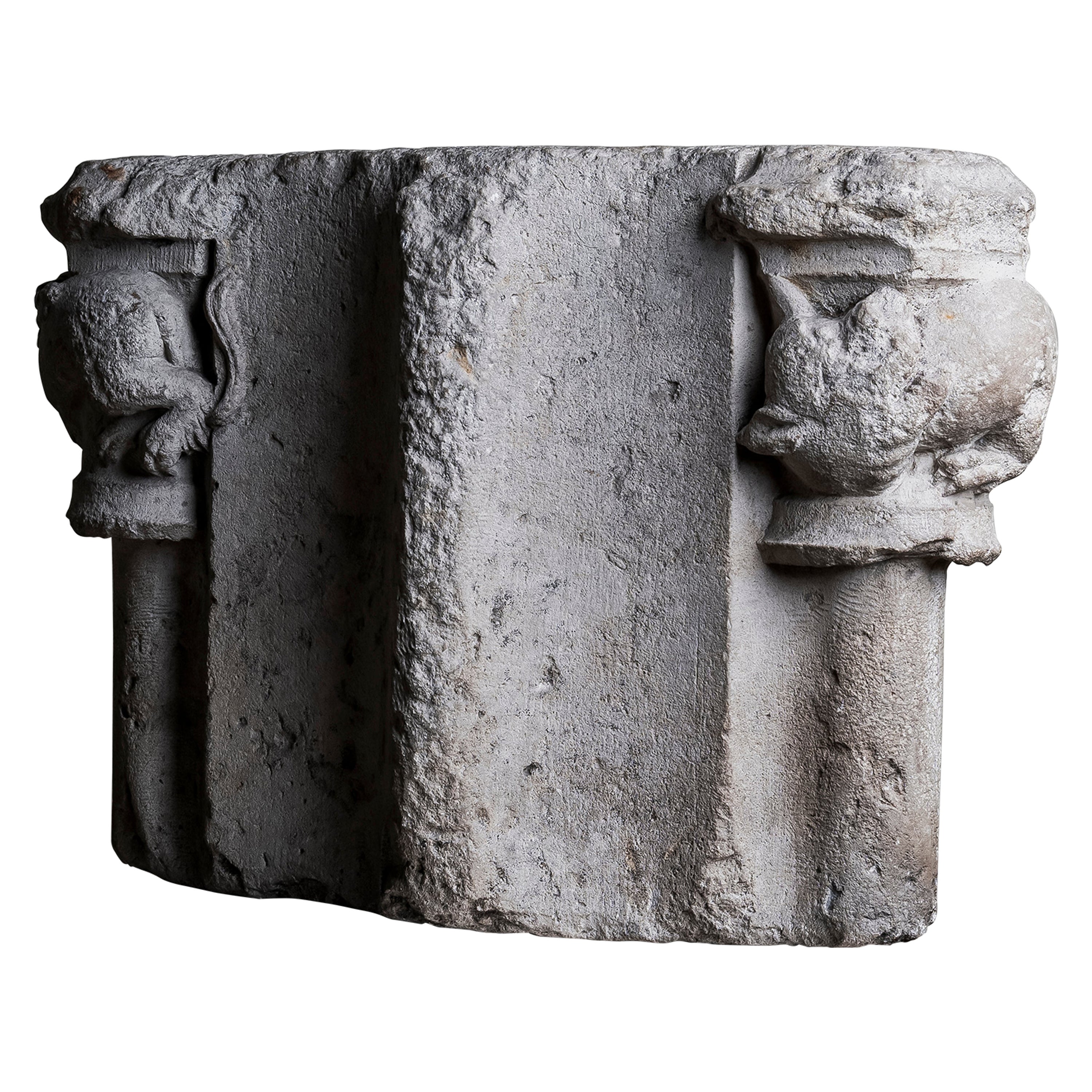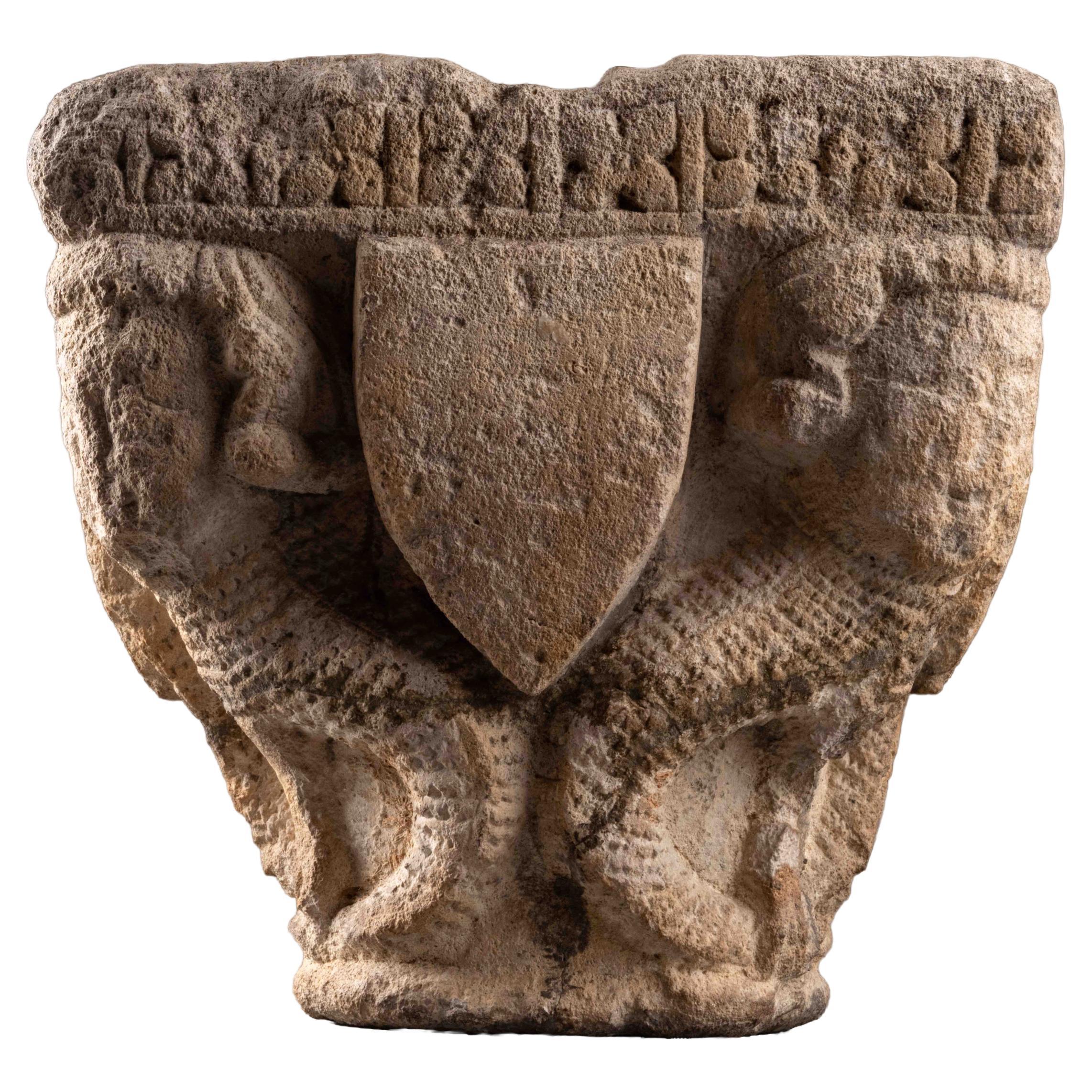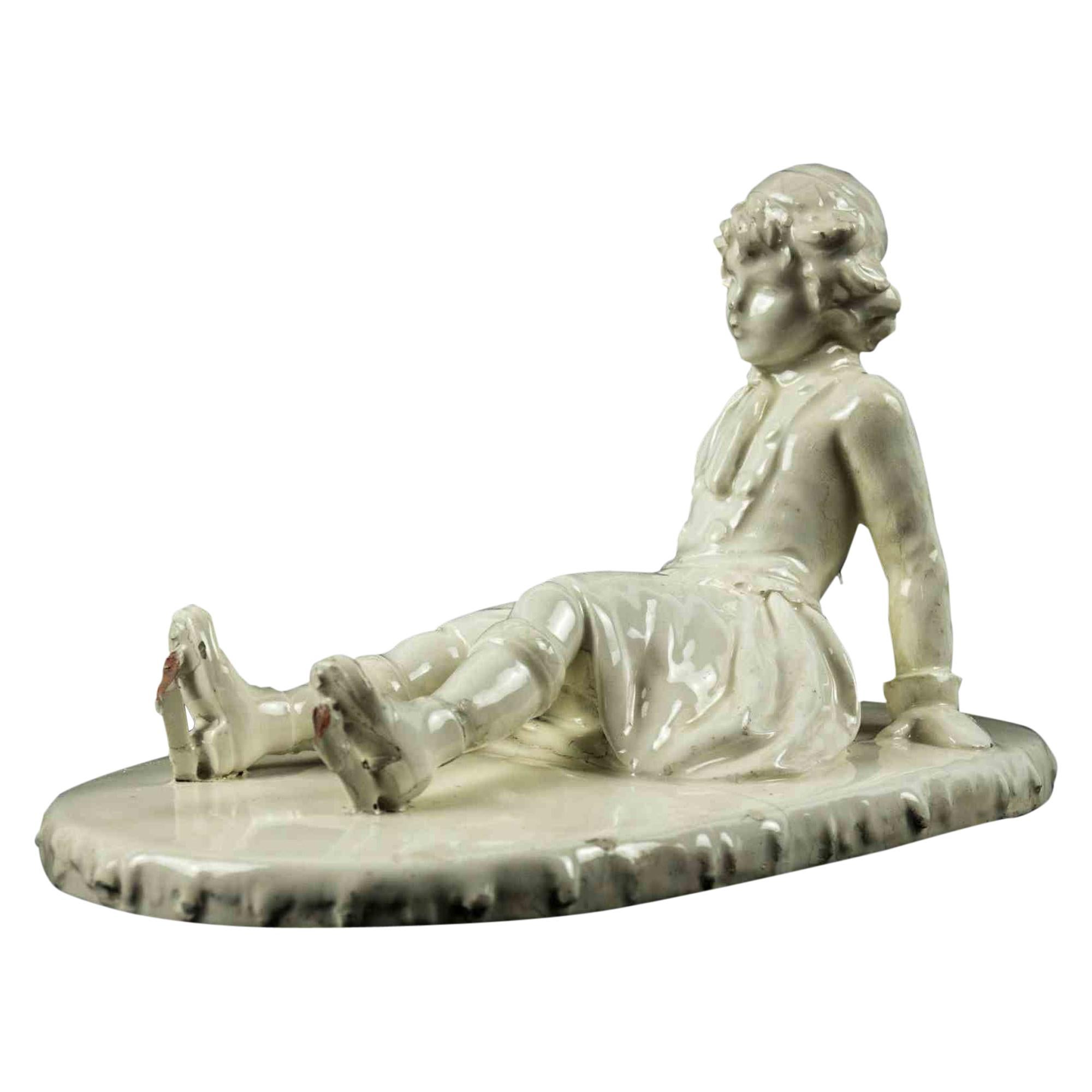Items Similar to Virgin and the Child, Mosan Region, Second Half of 13th Century
Want more images or videos?
Request additional images or videos from the seller
1 of 8
Virgin and the Child, Mosan Region, Second Half of 13th Century
About the Item
A polychrome sculpture depicting the Virgin and the Child
Mosan region, second half of 13th century
Polychrome wood
73 x 29 X 12 cm
Provenance :
Former Belgian private collection from the beginning of the 20th century
This remarkable early artwork portrays the Enthroned Virgin and Child, also known as Sedes Sapientiae, which translates to the 'Seat of Wisdom' or Throne of Wisdom and specifically alludes to Christ’s both divine and humane nature. Christ is considered as the Divine Wisdom incarnated through Mary (Logos Incarnata); Mary therefore is the bearer (the Throne) of this Divine Wisdom. The base for this theme was laid at the Council of Ephesos in 431 A.D. when Mary was dogmatised as given childbirth to Christ, and titled "Theotokos".
The Sedes sapientiae composition was central to the Marian cult during Romanesque times, with the Virgin appearing in her dual role both as Mother of God and of man, simultaneously presented with Christ seated on Her knee, whilst being enthroned as Queen of Heaven. From the 10th century onwards the "Sedes Sapientiae" emerges as the main –almost only- piece of freestanding sculpture; meaning independent from the architectural iconographic program of the church building. The „Sedes Sapientiae" probably is the idol of medieval Christianity and played an important part in the rural communities; the Sedes mediated between this world and the divine communion of the Saints in all possibly aspects of daily and ecclesial life.
Exquisitely carved, Mary is depicted seated on a throne in a rigid, frontal position, with the Christ Child standing on her left knee. Mary's countenance is directed toward the viewer, with an oblong face and a prominent high forehead. A subtle smile seems to grace her lips, and she wears a short veil, accentuating her delicate and symmetrical features. Her nose is long and straight, and her eyes possess an almond-shaped elegance.
Mary is attired in a tunic that drapes elegantly to just above the ground, with only one of her shoes visible.
While the Virgin appears serene and composed, her son, the Christ Child, exudes a more animated presence, particularly conveyed through the positioning of his feet. He personifies divine wisdom in human form, and his countenance bears an uncanny resemblance to that of a miniature man.
While the composition of the artwork adheres to the rigidity often associated with Romanesque sculpture, this characteristic is intriguingly contrasted by the graceful flow of the drapery and the expressive faces. The drapery, in particular, exhibits a refined quality, convincingly enveloping and revealing the forms beneath. Both Mary and the Christ Child are endowed with subtle, enigmatic smiles.
There are two prominent regions where the „Sedes Sapientiae" was developed and remained popular until the late 13th century: the South/East French / Pyrenean area, with as earliest example the now lost "Madonna of Clermont-Ferrand", dating from ca. 946; and the northern Rhine / Mosan area, with as earliest example the so called "Goldene Madonna" at Essen, dated between 973 and 1050.
This sculpture stands out due to its humanized depiction of the figures and the relative naturalism of the meticulously sculpted drapery. Its heavy drapery with multiple folds, almond-shaped eyes, straight nose, and understated smiles place it within a distinguished category of 'Sedes Sapientiae' sculptures originating from the Mosan region in modern-day Belgium, dating to the late 13th century. Rarely, it preserves traces of original polychromy.
Romanesque wooden sculptures from the 13th century are comparatively rare, especially when contrasted with the greater number of later works. Romanesque wood sculptures from the 13th century are scarce, compared to the healthy number of later ones; this magnificent representation is of high quality and greatest rarity.
- Dimensions:Height: 28.75 in (73 cm)Width: 11.42 in (29 cm)Depth: 4.73 in (12 cm)
- Style:Medieval (Of the Period)
- Materials and Techniques:
- Place of Origin:
- Period:
- Date of Manufacture:13th century
- Condition:Wear consistent with age and use.
- Seller Location:Bruxelles, BE
- Reference Number:1stDibs: LU6666234822652
About the Seller
5.0
Vetted Seller
These experienced sellers undergo a comprehensive evaluation by our team of in-house experts.
1stDibs seller since 2022
6 sales on 1stDibs
Typical response time: 5 hours
- ShippingRetrieving quote...Ships From: Bruxelles, Belgium
- Return PolicyA return for this item may be initiated within 3 days of delivery.
More From This SellerView All
- Double Romanesque Capital, France, 13th CenturyLocated in Bruxelles, BEDouble romanesque capital decorated with two fantastic animals France, 13th century Measures: 26,5 x 38,5 x 14,5 cm. This rare double cap...Category
Antique 15th Century and Earlier French Medieval Architectural Elements
MaterialsStone
- Romanesque capital with sirens - France 13th centuryLocated in Bruxelles, BERare romanesque capital with sirens France, XIII century Limestone 25 x 28 x 22 cm This finely carved Romanesque capital, executed in high relief from limestone, features four hyb...Category
Antique 15th Century and Earlier French Medieval Figurative Sculptures
MaterialsStone
- Rare Romanesque Capital Depicting Four Africans, Apulia, 13th CenturyLocated in Bruxelles, BELarge stone capital carved on each side in strong relief. The basket is covered with two crowns of vertical acanthus leaves which sprout from the astragal and fill the space between ...Category
Antique 15th Century and Earlier Italian Medieval Architectural Elements
MaterialsStone
- Gothic Capital with Foliate Decoration, 13th CenturyLocated in Bruxelles, BEGothic capital with foliate decoration France, limestone 13th century 16.5 x 17 x 12.5 cm The leaves are organically arranged around the core of...Category
Antique 15th Century and Earlier French Medieval Architectural Elements
MaterialsLimestone
- Bronze Mortar, Tuscany, Second Half of 16th CenturyLocated in Bruxelles, BEBronze mortar with garlands, flowers and putti - Tuscany , second half of 17th century. Measures: height 10 diameter : 13 cm Artisans and healers used mortars for grinding food...Category
Antique 16th Century Italian Renaissance Scientific Instruments
MaterialsBronze
- Large Terracotta Relief - Lombardy, First Half of 17th CenturyLocated in Bruxelles, BELarge Terracotta relief of the flight into Egypt Lombardy, first half of 17th century Painted terracotta 91 x 85 x 11,5 cm This event in the early life of Christ is recounted i...Category
Antique 17th Century Italian Baroque Figurative Sculptures
MaterialsTerracotta
You May Also Like
- 13th Century Virgin and Child from CataloniaLocated in Saint-Ouen, FRSeating on a bench-like throne the Virgin carries her child on her left knee. She bears an important crown high on her head .The Virgin has an ovoid face with bulging eyes, straight long nose and thin lips. The hair parts in the middle and are carved as thick horizontals parallel hair strands...Category
Antique 15th Century and Earlier Spanish Gothic Figurative Sculptures
MaterialsOak
- Rare 13th Century Christ on the CrossLocated in Saint-Ouen, FRThis wood Christ bears signs of time without diminishing its grace nor its interest. This Christ presents some characteristic of the previous century. While the feet are missing the position of his legs, parallel one to the other, let us think his feet where placed side by side as in the 12th century’s crucifix. The remains of his perizonium let us guess the cloth was very short, displaying the knees and a part of the thighs. The figure is straight, the arms horizontal, the hands open -with tha palm then pierced by nails- and the thumbs parallel to the other fingers as in most of the 12th century’s Christ on...Category
Antique 15th Century and Earlier French Gothic Figurative Sculptures
MaterialsWood
- Polychrome carved wood Virgin and Child from the 15th CenturyLocated in Saint-Ouen, FRPOLYCHROME CARVED WOOD VIRGIN AND CHILD FROM THE 15TH CENTURY ORIGIN: SOUTH GERMANY, SWABIA, NUREMBERG REGION PERIOD: 15th CENTURY Height: 94,6cm Width : 28 cm Depth : 18 cm Lime wood Original Polychromy Good state of conservation From 1430 onwards, sculpture underwent a profound stylistic renewal which continued until 1530, the so-called late Gothic period. In the Germanic countries, original sculptures flourished in an expressive and sensitive vein. This renewal was inspired by the art of Nicholas of Leiden, who was active in Strasbourg in the 1460's. His style broke with the refined and delicate art of the international Gothic style in force throughout Europe around 1400. The figures became more authentic and realistic. The bodies became denser. Clothes are animated by deep, broken folds, the fabrics are heavy and have a great decorative value. In addition, the polychromy is intended to be illusionistic. The painting makes it possible to restore the texture of the materials, the richness of the textiles and the natural skin tone of the characters. The dissemination of images through engraving and the great mobility of the artists led to the success of this style, which conquered the Upper Rhine, Swabian, Tyrolean and Franconian regions, contributing to the formation of a common stylistic identity in these regions. The economic boom in the flourishing German cities was conducive to the development of original production. Attracted by this prosperity, numerous workshops were set up in order to meet the orders of religious communities, the Church and the laity, including a clientele of middle-class rockers. This precious Virgin and Child is depicted standing on a crescent moon, her head encircled by a crown of tall flowers. Her long wavy hair spreads over her shoulders, framing her beautiful oval face. Under fine eyebrows drawn with a brushstroke, her almond-shaped, slightly drooping eyes look at the Child with infinite softness. She is dressed in a long red dress with a rounded neckline, belted under the chest. The heavy fabric of her dress spreads out in broken folds at her feet. On her shoulders she wears a golden cloak. The drapery has deep folds. She holds out her right hand while she holds the Christ Child with her left. Christ, with his well-defined hair, is naked. His cheeks are highlighted with red, he holds an apple in his left hand and with the other hand makes a sign of blessing towards the faithful. Virgins with Child on a crescent moon were very popular in the second half of the 15th century, especially as the central subject of altarpieces in southern Germany and Austria. The crescent moon on which Mary is standing is reminiscent of the Woman of the Apocalypse. Often equated with the Virgin Mary. This episode is taken from the Book of Revelation (12:1-6) 1 Then a great sign appeared in heaven: a woman clothed with the sun, with the moon under her feet and a crown of twelve stars on her head. ; 2 She was pregnant, and she cried out because she was in labor, in pain from giving birth. ; 3 Then another sign appeared in heaven: it was a great fiery red dragon, with seven heads and ten horns, and seven royal crowns on his heads. ; 4 His tail swept down a third of heaven's stars and threw them to the earth. The dragon stood in front of the woman who was about to give birth so that when she gave birth, he might devour her child. ; 5 She gave birth to a son, a male child who is to rule all the nations with an iron rod. Her child was snatched up to God and his throne. ; 6 Then the woman fled into the desert, where God has prepared a place for her. There she will be taken care of for one thousand two hundred sixty days. Some theologians see in this woman a reference to the Virgin Mary and in the child, Jesus. This remarkable work is a very fine example of sculpture from Swabian workshops in the last decades of the 15th century. It presents all the characteristic stylistic elements: a highly girdled silhouette, an abundant drapery with angular folds, but also a great physical presence accentuated by the polychromy that restores the anatomical details. This group is made of a wooden log. The deep folds of the drapery highlight the movement of the Virgin holding the child. Bibliography : Sophie Guillot de Suduiraut, Dévotion et Séduction, Sculptures souabes des musées de France, vers 1460-1530, Paris musée du Louvre-Éditions somogy, 2015 “Revelation 12 - Common English Bible...Category
Antique 15th Century and Earlier German Gothic Figurative Sculptures
MaterialsWood
- Vintage White Porcelain with Child, Italy, Second Half of 20th CenturyLocated in Roma, ITVintage white porcelain with child is a original decorative object realized in the Second half of 20th Century. Made in Italy. Hand-made. The object is realized in white po...Category
Late 20th Century Italian Figurative Sculptures
MaterialsPorcelain
- Pair of Moors. Venice, Second half of the 19th centuryBy Non-Standard Furniture and LightingLocated in Milano, ITPair of torch-holding sculptures depicting two Venetian Moors, one female figure and the other male. In a mirrored position of slight advancement, they hold a tray in one hand while ...Category
Antique Mid-19th Century Italian Baroque Revival Figurative Sculptures
MaterialsWood
- Gothic Virgin and Child with a PhylacteryLocated in Saint-Ouen, FRThis Virgin and Child is wearing clothes with a limited number of folds and showing a thickness characteristic of the Burgundy region. As a result of the presence in the region of th...Category
Antique 15th Century and Earlier French Gothic Figurative Sculptures
MaterialsWalnut
Recently Viewed
View AllMore Ways To Browse
Uncle Sam Flag Holder
Vaillancourt Santa
Vantines Incense Burner
Victor Gutierrez
Vintage Porcelan
Vintage Tinderbox
Wallendorf Mid Century Figurines
Yoruba Statue
Antique Chalkware Statue
Arch Angel Michael
Bernard Bloch
Blanc De Chine Chinese Figurines
Capodimonte Last Supper
Design Fornication
E Gaudez
German Figurines Orchestra
Gold Ak 47
Hermes Extinguisher





